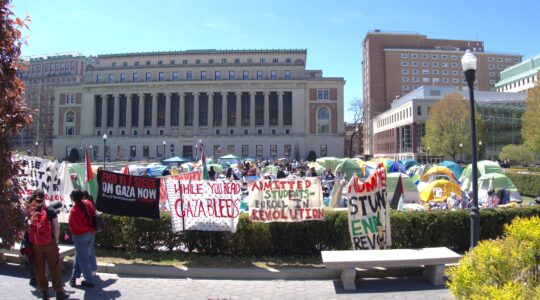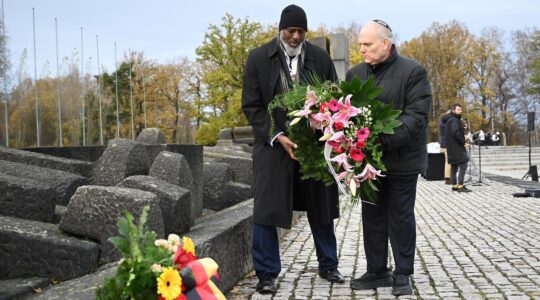The Orthodox Chief Rabbinate decided in 1949 that the Shoah (the Hebrew, literally meaning "catastrophe," that is now used for the Holocaust) should be commemorated on the 10th of Tevet, a minor fast day already established in the Jewish calendar.
In 1951, the Knesset ignored the Chief Rabbinate’s decision to incorporate commemoration of the Shoah into the existing calendar of traditional Jewish days of mourning. The first Knesset proposal was to hold Yom Hashoah (Holocaust Remembrance Day) on the 14th of Nisan, the anniversary of the Warsaw ghetto uprising (April 19, 1943) but that was rejected because the 14th of Nisan is the day immediately before Passover. You might imagine that the fighters of the Warsaw ghetto drew inspiration from the Passover story in selecting the night before Pesach as the date for their rebellion. In reality, they selected April 19th because the Germans entered the ghetto that day and were determined to deport the remaining Jews of Warsaw as a gift to Hitler whose birthday was April 20th.
The Knesset finally established Yom HaShoah on the 27th of Nisan, eight days prior to Yom HaAtzma’ut, a day that runs dafka – in the face – of the traditional Jewish calendar’s association of joy in the month of Nisan, and the Chief Rabbinate’s decision for the 10th of Tevet two years prior. Choosing to commemorate Yom HaShoah during the month of Nisan – a month that is supposed to be filled with the joy of Passover – reflected a desire to choose a different narrative than the one that forms the basis of two thousand years of Jewish history.
It is curious to note that the official name of Yom HaShoah is Yom HaZikaron LaShoah v’HaGevurah, Remembrance Day of the Holocaust and Heroism.
The second, less known, phrase of the day’s name derives from the Knesset’s decision to make the day about, "a day of commemoration of the Jews who perished and for those who showed resistance and heroism" (official Knesset website – emphasis added).
What is implied in the second part of the name is an effort to re-interpret the meaning of the Shoah – an event that represents the ultimate devastation when Jews were powerless to defend themselves – into a story of both weakness and power. That the Warsaw ghetto uprising was an act of bravery and light amidst darkness and evil is indisputable, and important. But, seen in a sea of blood and slaughter, and understood in the context of six million men, women, and children who were the victims of state-sponsored, systematized murder, the uprising was significant much more for its symbolic, rather than practical, value.
The modern state of Israel chooses to remember this moment of Jewish heroism in the Shoah because the lesson Israel learns from the Shoah is that it is Jewish strength and heroism, not God, that will save the Jews.
In Israel, one hears the sirens of Yom HaShoah and Yom HaZikaron (Israel’s memorial day for fallen soldiers) and sees on television stories of death and tears and sadness. The calendar creates a beginning, the utter blackness and death of the Shoah, a middle, the courage and sacrifice of those who died fighting, and an end, Yom Ha’Atzma’ut, the day of Jewish independence and freedom.
But in the competing, traditional Jewish narrative, the story continues. Yom Ha’Atzma’ut, like Yom HaShoah, runs against the grain of the traditional Jewish calendar. Yom Ha’Atzma’ut is a day of celebration that occurs in the midst of a period of mourning, the first 33 days of the Omer during which traditional Jews remember 20,000 students of Torah who perished. On Lag B’Omer, the dying came to an end and, in another few weeks, Shavuot arrives and traditional Jews celebrate standing before God at Mount Sinai to receive the Torah. The traditional Jewish narrative tells us that the freedom of Passover is not only freedom from slavery, but freedom with a purpose: to serve God.
Which narrative is "true?" Do Jews celebrate the God of history who saves from Egypt and gives the Torah at Sinai?
Or, after the Shoah, does the story end at Yom Ha’atzma’ut, having given up on a saving God and, instead, saved ourselves? The question at the heart of these competing calendars is not academic; it is critical to the Jewish future.
As the twenty-first century begins, do Jews find themselves with a state of their own, a safe haven for the first time in two thousand years, but existentially alone in the wilderness? No Jew with a modicum of knowledge of the suffering and persecution that befell Jews for thousands of years would turn away from our newfound ability to defend ourselves. We have independence, for which we should be grateful, but at what cost, and for what purpose?
Support the New York Jewish Week
Our nonprofit newsroom depends on readers like you. Make a donation now to support independent Jewish journalism in New York.
On Yom Ha’Atzma’ut, I sing Hallel prayers, another liturgical statement: we officially praise God for giving us a new beginning. But as I sing to Him, I am haunted by His absence 70 years ago when we needed Him the most. Does Yom Ha’Atzma’ut lead to Sinai? Can Israel forgive God and find Him in history again?
Yom HaShoah will take place this year on Monday, May 2nd, 2011. Yom HaZikaron will take place on Monday, May 9th. Yom Ha’Atzma’ut will take place on Tuesday, May 10th. This was adapted from an article that appeared in the journal, Conservative Judaism, Spring 2009.
The New York Jewish Week brings you the stories behind the headlines, keeping you connected to Jewish life in New York. Help sustain the reporting you trust by donating today.




